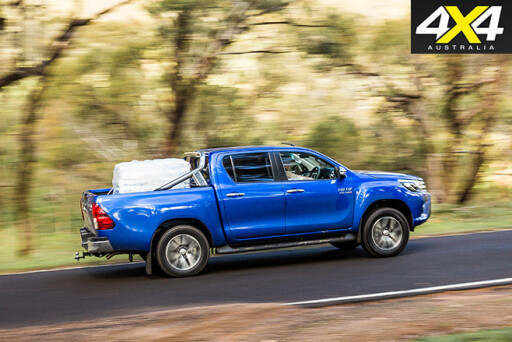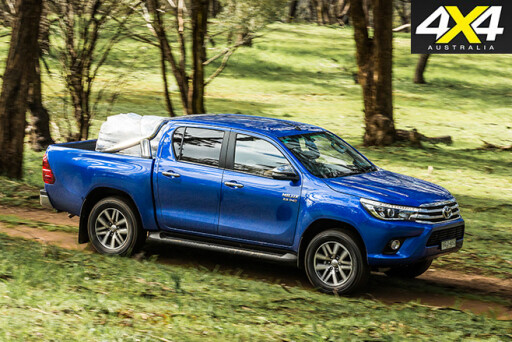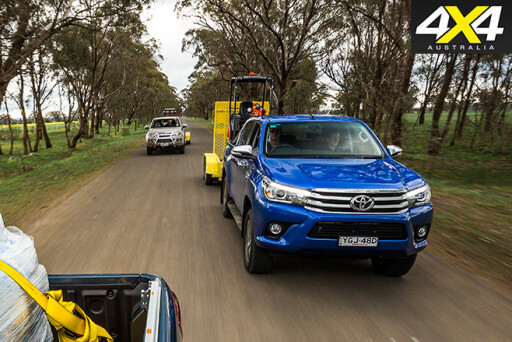
Today’s popular 4x4 dual-cabs make big claims when it comes to tow ratings and payloads, but are they really up to serious yakka?
We test the Toyota Hilux to see how its GCM, GVM and Payload fare against other industry icons.
LOAD TEST
Toyota’s eighth-generation Hilux brought a smaller diesel (down from 3.0 to 2.8 litres) but a big jump in towing capacity.
The payloads remain modest, however, despite an increase of the diesel’s GVM from 2780kg to 3000kg, as the vehicle itself gained weight that negated much of the extra GVM.
 The truth is the Hilux has the lowest payload rating of our seven utes, and even the lighter SR-spec dual-cab pick-up can’t technically carry (by around 40kg) our driver, observer, towbar and 800kg pallet of bagged cement that we used to test all the vehicles.
The truth is the Hilux has the lowest payload rating of our seven utes, and even the lighter SR-spec dual-cab pick-up can’t technically carry (by around 40kg) our driver, observer, towbar and 800kg pallet of bagged cement that we used to test all the vehicles.
There are four foldaway tie-down eyes – cast rather than extruded metal – in the back of the Hilux’s tub. Once the 800kg pallet was in and secured the rear suspension dropped 60mm. In other words, it coped as well as any rival and much better than some.
Once underway up the hill you could feel the nose was a little up, but steering remained nicely positive. Impressive stability, too, with good sway and roll control from the chassis and no bottoming on the bumps. All up, the Hilux feels very composed, despite being at max payload and then a smidge!
 The 2.8-litre was also a polished performer when coping with the 970kg payload and hardly felt the weight at all. With 450Nm on tap at just 1600rpm it isn’t far shy of what the considerably bigger 3.2L fives in the Ford and the Mazda can do – and it certainly felt every bit as strong as its 450Nm claim. It’s a sweet engine and bettered all the others in terms of general refinement, though it’s worth noting Ford’s Ranger and Mitsubishi’s Triton came close.
The 2.8-litre was also a polished performer when coping with the 970kg payload and hardly felt the weight at all. With 450Nm on tap at just 1600rpm it isn’t far shy of what the considerably bigger 3.2L fives in the Ford and the Mazda can do – and it certainly felt every bit as strong as its 450Nm claim. It’s a sweet engine and bettered all the others in terms of general refinement, though it’s worth noting Ford’s Ranger and Mitsubishi’s Triton came close.
The six-speed auto also brought a refined feel, with quick and smooth shifts, and it worked nicely with the engine in getting the 800kg up the hill with a minimum of fuss. It was also good on the descent, as it readily auto backshifted once the brakes had been tapped. Does it need to be explained that this means less reliance on the gearbox’s manual tip-shift?
Not ideal with this new six-speeder, especially with so much weight on board, are the very tall fifth and sixth gears, which are both overdrives. Fifth gear here is actually taller than fifth in the superseded five-speed, despite the fact that there’s still an extra gear to go!
 The long and short of it is that the engine can’t often hold sixth at legal highway speeds on undulating roads, even with a light load, so it tends to shuffle between fifth and sixth. To put it another way, it’s well-geared for Europe.
The long and short of it is that the engine can’t often hold sixth at legal highway speeds on undulating roads, even with a light load, so it tends to shuffle between fifth and sixth. To put it another way, it’s well-geared for Europe.
TOW TEST
While the manual Hilux gets the magic 3500kg towing tick, the auto comes in at 3200kg, so our Hilux was matched with the lighter 2800kg trailer weight we used when putting the Triton through its paces.
The Hilux’s 130kW/450Nm 2.8 is a very civilised little engine and this is still the case under load. It doesn’t have the same launch factor as the Ford/Mazda duo, or even the Holden for that matter, but it pulled away confidently and with purpose. The six-speed slid through the cogs well and did its utmost to keep the revs within the engine’s wide torque band. Climbing the hill at 3000rpm in second gear saw the Hilux haul very well.
 On the downhill the transmission needed a firm hand and a few measured stabs of the brake pedal to keep things in check.
On the downhill the transmission needed a firm hand and a few measured stabs of the brake pedal to keep things in check.
The rear suspension of the Toyota feels every bit as work-ready as the Hilux’s image and reputation would suggest. The outboard spring mountings proved very stable under load and the vehicle remained reasonably flat in corners. It was also easy to steer and control, even when bleeding off speed on the downhill run.
Even though the Hilux engine shares the same displacement as the Holden, the Toyota felt a little more revvy. However, the conservative engineering approach that is a hallmark of the marque was evident. You get the feeling that the Hilux has more to give but is holding back.
 At our lower 2800kg tow load the Hilux felt like a great all-rounder, but in typical Toyota fashion, it didn’t want to brag about it.
At our lower 2800kg tow load the Hilux felt like a great all-rounder, but in typical Toyota fashion, it didn’t want to brag about it.
SPECS: TOYOTA HILUX*
Engine 3.2-litre 5-cyl turbo-diesel
Max power/torque 130kW/470Nm
Gearbox six-speed automatic
4X4 System dual-range part-time
Kerb Weight 2068kg to 2200kg
GVM 3200kg
Payload 1000kg to 1132kg
Towing capacity 3500kg
Towball download 350kg
GCM 6000kg
Fuel tank capacity 80L
ADR fuel claim 9.2L/100km
*4x4 dual-cab pick-up automatics only
TOYOTA HILUX PRICES*
SR $46,490
SR5 $53,990
SR5+ $55,990
*2.8-litre 4x4 dual-cab pick-up manuals

COMMENTS